Consistent Greatness 2016: Running Backs
I just want the best football players on my team. Whether it’s a young receiver on the verge of breaking out, a veteran tight end who has finally become an offensive weapon at the end of his career, or a running back playing in his prime; the goal is to fill my roster with outstanding players.
I am a firm believer that any and all strategies can work, assuming you pick the right players and make the right moves. A dynasty team merely begins in the startup draft, but winners are built over time. If you start with a productive struggle, eventually you will need production from every position to actually go out and win. If you are gunning for a Championship each and every year from the moment your first pick is made, you are chasing points. Running backs should not be overlooked in startups, and much like 2017 rookie picks are verging on being too overvalued, running backs in dynasty have been dropping off radars for the last few years. It’s time to take advantage.
Running Backs
Why do I love running backs? Because they are usually the biggest difference between winning and losing every week and season. With the unbelievably outstanding depth of talent at the wide receiver position and the consistent high production at quarterback by average talent, the running back position is where there consistently seems to be the biggest gap between the top few and the rest. Devonta Freeman owners most likely had a seven or eight game stretch of wins early in the season, and those who put faith back in Adrian Peterson and Doug Martin would be trumping the majority of owners without two startable running backs each week.
The Method
For more of the background of the method, see part one. Essentially, the idea is to calculate baselines for a top 12 (RB1) and top 24 (RB2) week, then see how many times players reached those baselines.
RB1 – 17.0
RB2 – 11.5
The top 50 backs in the May DLF ADP data were tried and tested (exluding rookies), and having worked out how many times they hit the baselines in each of the last three years, I compared it to the numbers of games they played to calculate a percentage. The data is presented below.
The Key
- GP – Games played
- RB1/2 – Weeks the player scored 11.5 points or more
- RB1 – Weeks the player scored 17.0 points or more
- RB2 – Weeks the player scored between 11.5 and 16.9 points
- % – Percentage of weeks the player placed in each category versus games played
Notes
- I used PPR scoring from the FFToday stats page
- Playoff games are not included
- Jay Ajayi and Tevin Coleman were both removed, having no weeks in the top 24
The Results
[am4show have=’g1;’ guest_error=’sub_message’ user_error=’sub_message’ ]
Top RB1/2%

- The top two have not changed from last year, but their percentages have dropped (considerably, in DeMarco Murray’s case)
- Todd Gurley jumps straight in at number five – no surprise
- Karlos Williams is the odd name out here. He showed me that a top 24 back has a low bar (50 yards plus a touchdown and you’re in), but can he produce at a high level as a full-time back?
- It’s not unfathomable that Danny Woodhead just continues producing at a high level for years to come – he was the third overall running back with just 97 attempts and 335 yards on the ground. Avoiding the ‘wear and tear’ of the ground game could prolong his production
- Last year, eight of the top 12 were 27 or older. This year, only six are
- Jacob Rickrode talks a lot about how often the same players are in the top 12 and 24 every year – and it’s the same with weekly scoring. For as long as the greats such as Jamaal Charles, LeSean McCoy and Peterson play, they are worth owning and starting
Bottom RB1/2%
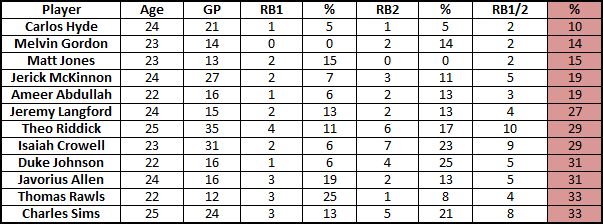
- This could be a list of the worst top 24 scorers, or it could be a list of some of my favorite players to target heading into next season – Carlos Hyde, Melvin Gordon, Jerick McKinnon, Ameer Abdullah and Duke Johnson are all backs who I believe could blow up
- Matt Jones and Isaiah Crowell are the two who I’d argue have been afforded the chance to produce, but haven’t taken it. I believe they will both drop off the radar soon, and Jones is worth moving at his current value
- Notice how this list is all young players – their ADPs are completely on potential and not production
Top RB1%
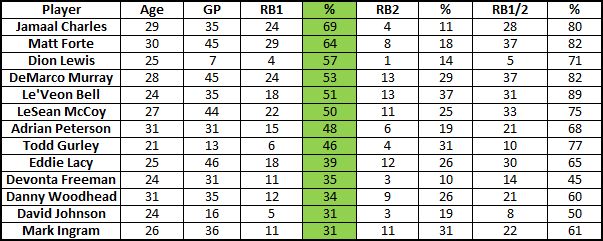
- Jamaal Charles dominates RB1 weeks, and always has. He is so explosive, and offers that shot at an absurd score every time he is on the field
- What do you do with Dion Lewis? We might be able to help you decide.
- I’m of the opinion that LeSean McCoy is undervalued as a productive asset. Sure, his value may not rise very far ever again, but you’ll get points for the next two or three seasons. In Buffalo, he was a top 24 back in nine of 12 games and a RB1 in five. He’s the perfect back to balance with a roster of younger receivers
- It’s impressive to see Devonta Freeman in here considering he played extremely sparingly in his first season
- Look at the difference between the top (69%) and the bottom (31%). These top players are such difference-makers
Bottom RB1%
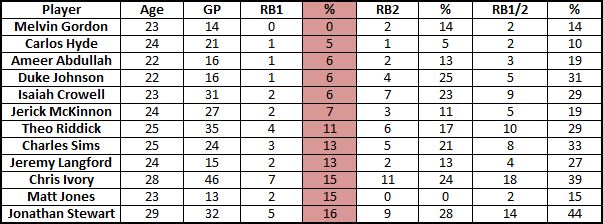
- Gordon was really bad last year. There’s no denying it. He was bad at producing, but was it all on him? Keenan Allen went down, the offensive line didn’t produce, and he didn’t score a touchdown all year. All of these things should change next year, and I’m using this as an opportunity to acquire him
- Jeremy Langford had all of his top 24 games in a four week stretch. Nothing before or after. What can we expect next year?
Top RB2%
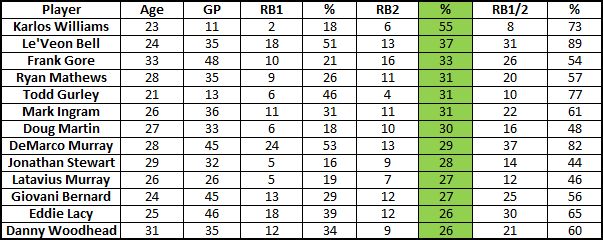
- Among quarterbacks, the QB2 list is one of ‘averageness’, but considering the scarcity of regular top 24 weeks from running backs, the players on the RB2 list are worth paying attention to
- Many owners build around receivers and ignore backs until later in the draft. Cheap veterans who regularly hit the top 24 are the players who keep those teams competitive – I don’t know how long Frank Gore can do this for, but players like him, Ryan Mathews and Jonathan Stewart are super cheap but at least get decent points (even if the weekly upside isn’t there)
Bottom RB2%
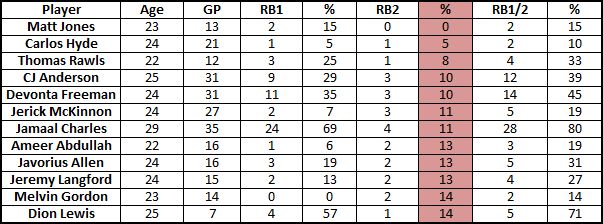
- Matt Jones and Thomas Rawls showed the ability to explode, but it was boom or bust for both
- Freeman and CJ Anderson have very similar numbers, they just scored them at different times. If I could sell Freeman for ‘Anderson plus’, I would
- Charles amazes me, because he goes big almost every time he plays – he has 24 RB1 weeks compared to 4 RB2 weeks. Stunning
Superstar Weeks
I believe superstar weeks are very important in establishing the ‘elite’ performers based on games played. How often will a player simply take over and win a head-to-head matchup for me? I calculated this year’s running back superstar week baseline by splitting in half the average RB1 requirement (17.0) and the average number of points scored by the top overall back each week (34.6) to get a baseline of 25.8 points.

- Bell and Charles have both missed 13 games over the past three years, but have been the best performers when on the field
- It’s astounding how consistently Matt Forte has been at his peak. Will he be able to continue it in his new surroundings?
- I crowned CJ Anderson as my top buy of last off-season, but perhaps I was too late. Or conversely, was I too early? He’s fairly cheap to acquire this summer, and has the big-game ability you covet. This team will be geared to run the ball
- Matt Jones really did ‘go off’ in his two only productive games of the year (over 27 points in each), but didn’t hit the top 24 any other time
Conclusion and Player Thoughts
One player who sat firmly in the middle of all of this and didn’t reach any list was Jeremy Hill, and Giovani Bernard only snuck onto the RB2 list. As I mentioned last year, Bernard actually had a better points per game rate in Hill’s rookie year than before the bruising back came along, suggesting that when one produces, the other rises up with them. But the stat that piqued my interested was this:
Jeremy Hill attempts by year:
2014 – 222
2015 – 223Yards:
2014 – 1124
2015 – 794— James Simpson (@JS_Football) June 12, 2016
Far from discouraging me, it reminded me of how usage will lead to production if coaches are committed to a player and the offense is performing. I think the Bengals will continue to feed Hill, and at RB25 I have no problem picking him up.
What do I say about DeMarco Murray? In his five games with more than 15 carries in Philadelphia, he was a RB1 in four of them (80%). As a fan, he frustrated the heck out of me with his slow, clumpy, hesitant style – but with the volume he produced fantasy points. Did his performance in Dallas in 2014 prove he is ‘more than capable’, or did he simply show that many backs in this league are more than capable of big seasons? Assuming the Titans give him the volume he demands, he might well be able to get back to productive fantasy ways. He’s only 28 and finished as the second overall back in 2014 and sixth overall in 2013 – it’s not farfetched.
I can’t write this piece without mentioning the forgotten Arian Foster:
![]()
Foster is one of my favorite backs of all time, and my first consistent greatness study into running backs helped me acquire him everywhere before his comeback season in 2015. If he was in the DLF top 50 this year, he’d be tied sixth in RB1%, tied fourth in RB1/2% and fourth in Superstar %. I hope he gets one more shot.
Last year, targets included Peterson, Martin, Anderson and Foster – all identified as players whose chances of hitting on a week-to-week basis outweighed their ADPs and value. Some names I like this year are Charles (RB12), Anderson (RB13), McCoy (RB18), Duke Johnson (RB21), Gordon (RB23) and Abdullah (RB28). Obviously, Gordon and Abdullah heavily disappointed in their rookie seasons, but I can’t fathom what has really changed in a year. Of course it would have been great to see them put up some production straight away, but what were drafters truly expecting? I was buying them last year with a long term view, and I’m buying them again this year with that same view – it’s just now, I get them at half price. Both are extremely talented (as is Johnson), and I will enjoy their breakouts.
Previous Years
- 2014 RBs (non-PPR)
- 2014 WRs (non-PPR)
- 2015 QBs
- 2015 RBs
- 2015 WRs
- 2015 TEs P1
- 2015 TEs P2
- 2015 Summary P1
- 2015 Summary P2
- 2015/16 Mid-Season QBs/TEs
- 2015/16 Mid-Season RBs/WRs
- 2016 QBs
Who stood out to you? What did you gain from studying the data? All feedback is welcome. The full data set is below.
| Player | Age | GP | RB1 | % | RB2 | % | RB1/2 | % | SS | % |
|---|---|---|---|---|---|---|---|---|---|---|
| Todd Gurley | 21 | 13 | 6 | 46 | 4 | 31 | 10 | 77 | 2 | 15 |
| Le'Veon Bell | 24 | 35 | 18 | 51 | 13 | 37 | 31 | 89 | 9 | 26 |
| David Johnson | 24 | 16 | 5 | 31 | 3 | 19 | 8 | 50 | 1 | 6 |
| Lamar Miller | 25 | 48 | 12 | 25 | 12 | 25 | 24 | 50 | 3 | 6 |
| Devonta Freeman | 24 | 31 | 11 | 35 | 3 | 10 | 14 | 45 | 4 | 13 |
| Doug Martin | 27 | 33 | 6 | 18 | 10 | 30 | 16 | 48 | 1 | 3 |
| Eddie Lacy | 25 | 46 | 18 | 39 | 12 | 26 | 30 | 65 | 7 | 15 |
| Adrian Peterson | 31 | 31 | 15 | 48 | 6 | 19 | 21 | 68 | 5 | 16 |
| Carlos Hyde | 24 | 21 | 1 | 5 | 1 | 5 | 2 | 10 | 1 | 5 |
| TJ Yeldon | 22 | 12 | 3 | 25 | 3 | 25 | 6 | 50 | 0 | 0 |
| Mark Ingram | 26 | 36 | 11 | 31 | 11 | 31 | 22 | 61 | 0 | 0 |
| Thomas Rawls | 22 | 12 | 3 | 25 | 1 | 8 | 4 | 33 | 1 | 8 |
| Jamaal Charles | 29 | 35 | 24 | 69 | 4 | 11 | 28 | 80 | 9 | 26 |
| Melvin Gordon | 23 | 14 | 0 | 0 | 2 | 14 | 2 | 14 | 0 | 0 |
| Dion Lewis | 25 | 7 | 4 | 57 | 1 | 14 | 5 | 71 | 1 | 14 |
| CJ Anderson | 25 | 31 | 9 | 29 | 3 | 10 | 12 | 39 | 6 | 19 |
| Giovani Bernard | 24 | 45 | 13 | 29 | 12 | 27 | 25 | 56 | 2 | 4 |
| Ameer Abdullah | 22 | 16 | 1 | 6 | 2 | 13 | 3 | 19 | 0 | 0 |
| Matt Jones | 23 | 13 | 2 | 15 | 0 | 0 | 2 | 15 | 2 | 15 |
| Duke Johnson | 22 | 16 | 1 | 6 | 4 | 25 | 5 | 31 | 1 | 6 |
| Jeremy Langford | 24 | 15 | 2 | 13 | 2 | 13 | 4 | 27 | 1 | 7 |
| Jeremy Hill | 23 | 32 | 8 | 25 | 7 | 22 | 15 | 47 | 2 | 6 |
| LeSean McCoy | 27 | 44 | 22 | 50 | 11 | 25 | 33 | 75 | 4 | 9 |
| Latavius Murray | 26 | 26 | 5 | 19 | 7 | 27 | 12 | 46 | 0 | 0 |
| DeMarco Murray | 28 | 45 | 24 | 53 | 13 | 29 | 37 | 82 | 6 | 13 |
| Karlos Williams | 23 | 11 | 2 | 18 | 6 | 55 | 8 | 73 | 0 | 0 |
| Matt Forte | 30 | 45 | 29 | 64 | 8 | 18 | 37 | 82 | 11 | 24 |
| Jerick McKinnon | 24 | 27 | 2 | 7 | 3 | 11 | 5 | 19 | 0 | 0 |
| Charles Sims | 25 | 24 | 3 | 13 | 5 | 21 | 8 | 33 | 0 | 0 |
| Ryan Mathews | 28 | 35 | 9 | 26 | 11 | 31 | 20 | 57 | 0 | 0 |
| Jonathan Stewart | 29 | 32 | 5 | 16 | 9 | 28 | 14 | 44 | 0 | 0 |
| Danny Woodhead | 31 | 35 | 12 | 34 | 9 | 26 | 21 | 60 | 2 | 6 |
| Isaiah Crowell | 23 | 31 | 2 | 6 | 7 | 23 | 9 | 29 | 1 | 3 |
| Theo Riddick | 25 | 35 | 4 | 11 | 6 | 17 | 10 | 29 | 0 | 0 |
| Javorius Allen | 24 | 16 | 3 | 19 | 2 | 13 | 5 | 31 | 1 | 6 |
| Chris Ivory | 28 | 46 | 7 | 15 | 11 | 24 | 18 | 39 | 1 | 2 |
| Frank Gore | 33 | 48 | 10 | 21 | 16 | 33 | 26 | 54 | 0 | 0 |
[/am4show]
- 2022 Rookie Class: An Early Look at Kenny Pickett, QB Pittsburgh - January 31, 2022
- Dynasty Fantasy Football Rookie Update: Quez Watkins, WR PHI - July 15, 2020
- Dynasty Fantasy Football Rookie Update: John Hightower, WR PHI - July 7, 2020

































































